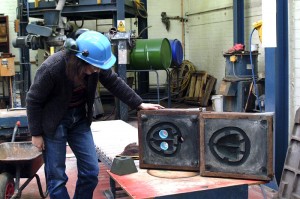Monday October 22nd – New Work ‘Work’ and ‘Non Work’
Since my last blog, I have started some new work in the studio, experimenting with an idea I’ve had for a while based on ideas about ‘Work’ and ‘Non Work’, and inspired by a piece by Alghiero Boetti I saw in his recent show at Tate Modern. Basically I lay on the floor in my studio in various relaxed sunbathing poses, got someone to draw around me in chalk, then infilled the space with various items, including discarded Whitworth Art Gallery workshop leaflets, and a series of completely useless clay objects made with my fingers and hands. Will attach photos soon. The freshness of this new work and the speed with which I’ve been able to make it has been very invigorating, and its in direct response to my Tate research. I’m also starting some interventions with beautiful industry posters from the 1950s and 1960s which my partner found in a drawer in an old college.
On Monday I was back in Tate at my desk with a better understanding of whats in the Archive and how it works. After a short recap, I spent all day looking at correspondence between the apg and placements in industry they were trying to secure for artists-this is an aspect of the Archive particularly relevant to my own practice.
Excerpt from report Barbara Steveni after meeting with Mr Croall, BOAC Advertising Manager 27th Aug 1969:-….”I told him that apg was an artist’s organisation which was about the activities of artists working now – that nothing was barred from an artist’s vocabulary… from plastics, steel, airlines, coalmines..” (TGA 20042/1/2/13/5/1.)
Report includes an early reference to “the young artist”, Richard Long!! and what is being called “Land Art”.
Announces 1st industrial artist-fellowship – Garth Evans at British Steel Corporation…..”APG is concerned with the artist in the capacity of engineer of conceptual material... of which he is ‘author’ and for which he carries the responsibility…( TGA 20042/1/2/ 15) unarchived letter.
If the principle of the apg placement had worked, it would be amazing if now every factory has a resident artist, an ‘incidental person’, paid on the payroll, creating good paid work for that artist-it would be a revolution and society, the country, the economy, would be transformed as a result.
Curious contradiction 20042/1/2/14/11 Letter from Barbara Steveni to Edgar Anstey, British Railways June 18th 1973.
“….If this can be put over at the beginning of any conversations with British Rail, I feel we won’t fall into mistaken ideas that this kind of work has anything to do with art in museums.Though there is every hope that some of it might lodge there later.”
I would ask the question why couldn’t a new kind of art, a new way of thinking have a new home, a new platform – apg still needed the cuedos and validation of the museum, which seems a contradiction in the light of their otherwise visionary thinking -maybe another suitable platform didn’t really exist at the time.

Jill Randall with”Breath” in Experimental casting foundry, Magnesium Elektron. Photography David Bennett.
The Tate research has prompted me to revisit and reappraise the Residency I undertook at Magnesium Elektron, a magnesium-processing factory in Salford from 2001-2003. Thought more about my “slow burn” approach to industry residencies, setting up studio in the workplace and engaging people in the creation of artworks, not educating, but an exchange based on mutual respect for each others professions. A response based on building up relationships and allowing things to happen. Whole process and what it reveals is the artwork. Time spent there is the artwork, the people are the artwork.The environment is the artwork. The revelation of the past history of that industry and its workers is the artwork. Thinking in that place about the place is the artwork (Such as my working with vintage blueprints found in my workshop.)
I’m very excited as I have a place at a Public Discussion on apg with some very important people including founder of apg Barbara Steveni at Raven Row tomorrow night and have thinking about what questions I might ask.
1. WHAT IS THE LEGACY OF APG FOR TODAY’S ARTISTS AND SOCIETY IN GENERAL? Where should the apg legacy be lodged? Old correspondence indicates the museum would eventually be the repository of apg work and this seems a contradiction for a new kind of art and artist, and new way of thinking. Is “I Am an Archive” an attempt to do this? “I Am An Archive” is an ongoing live project where Barbara Steveni revisits sites associated with apg to ‘tell its story’.
2. Who eventually benefitted and how from the industry placements?
3. Did the artists negotiate how and with whom they should work. Is this documented? (from the artists perspective.)
